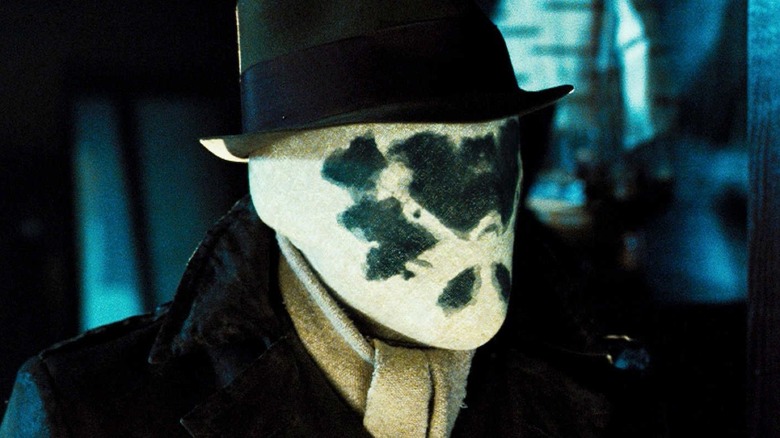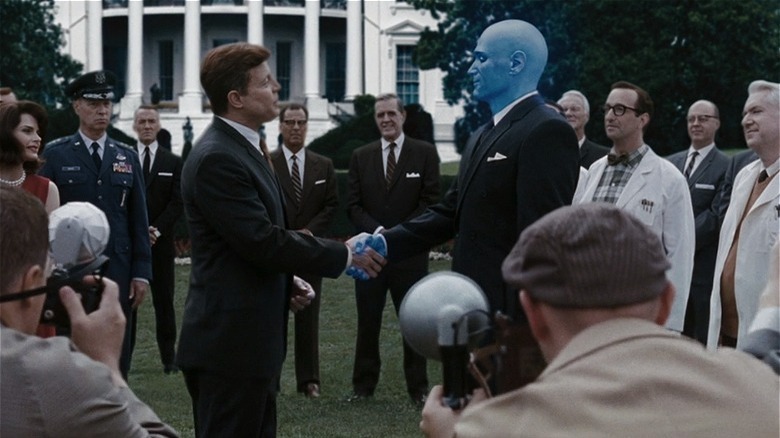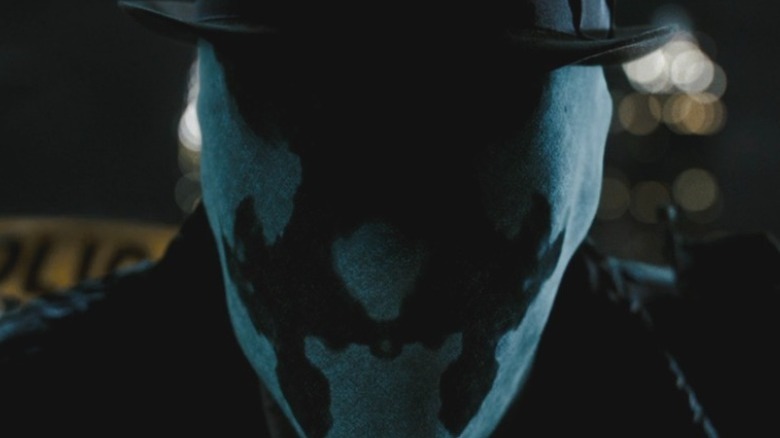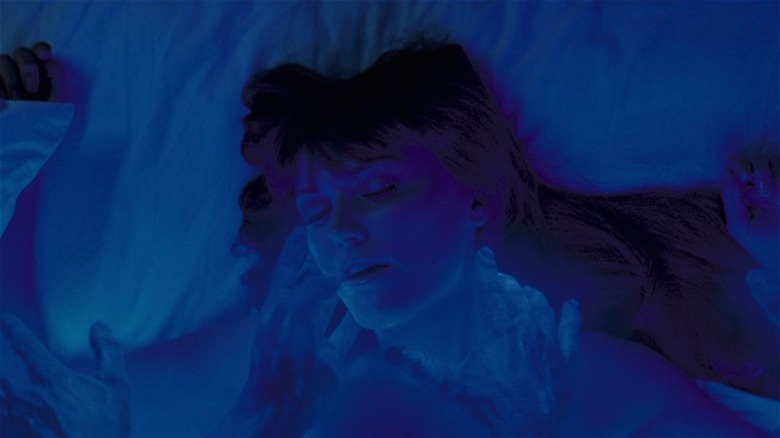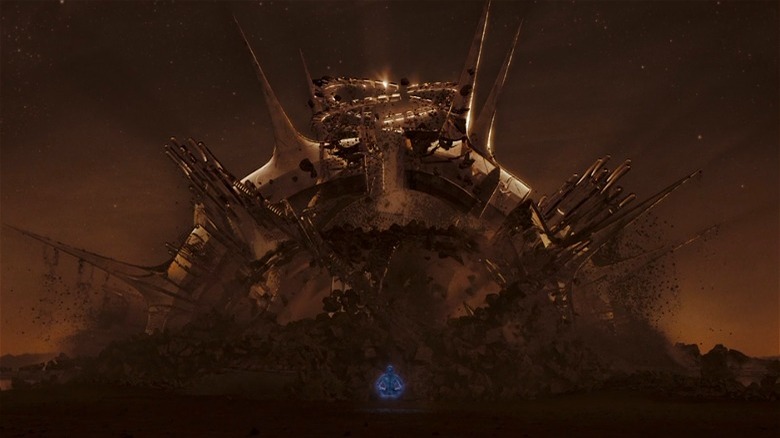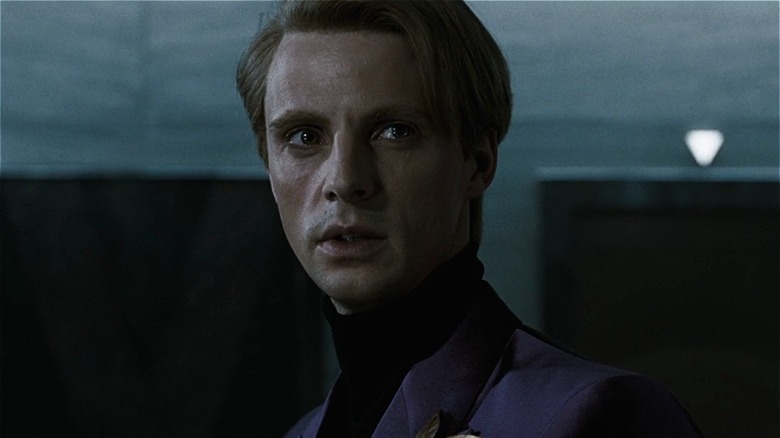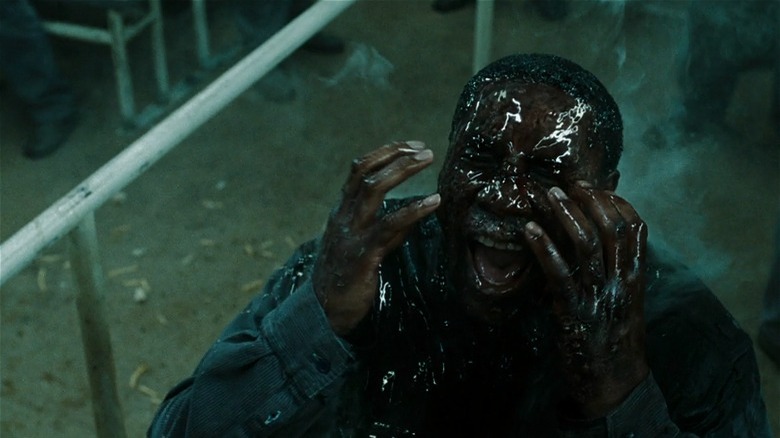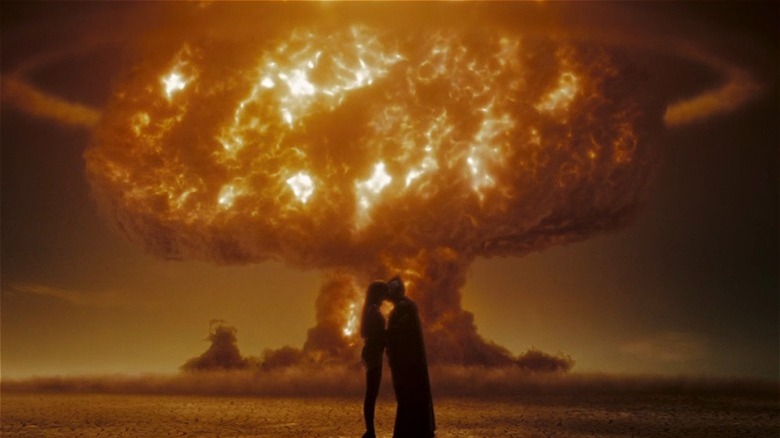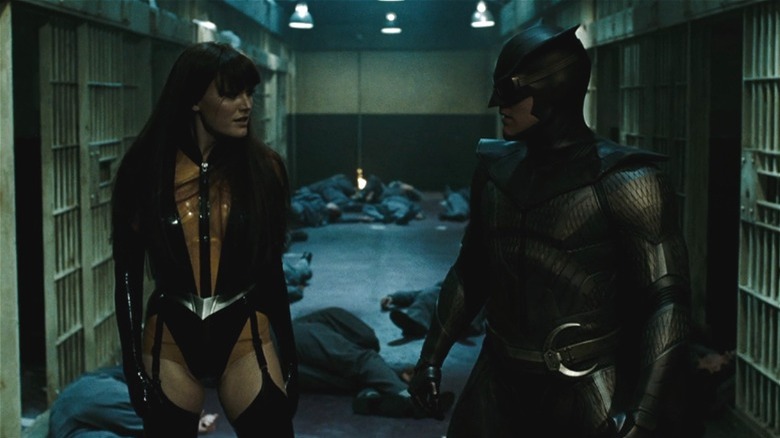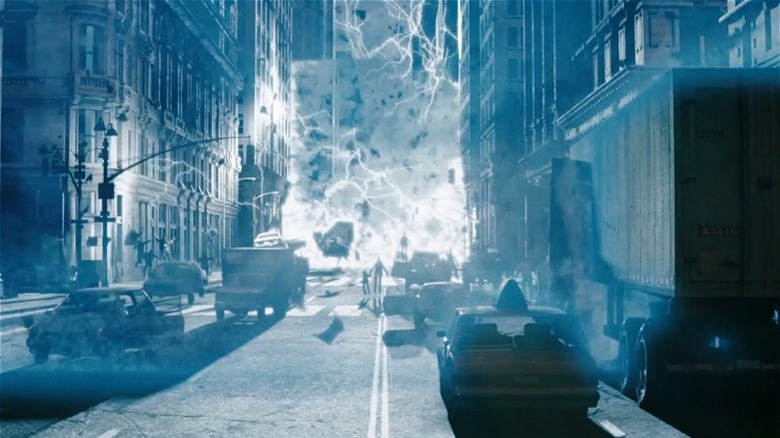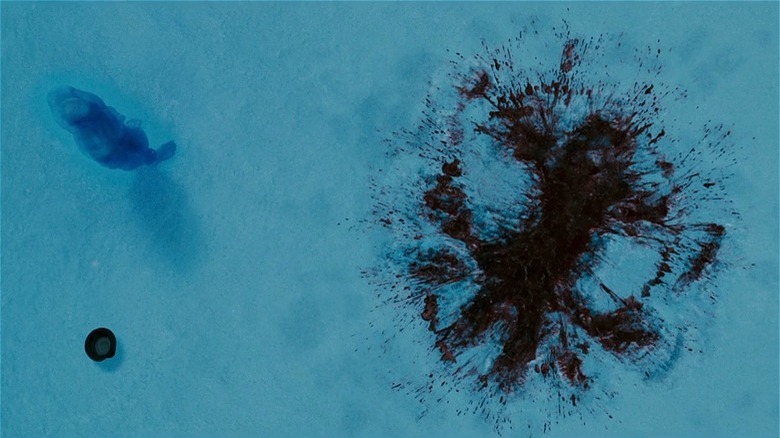10 Moments In Zack Snyder's Watchmen That Actually Worked Well
Zack Snyder's polarizing 2009 film adaptation of "Watchmen" has the unfortunate distinction of being arguably the third-worst "Watchmen," behind the original graphic novel and the later HBO miniseries. It's a sprawling, convoluted film that made superheroes dark, gritty, and philosophical at a time when the considerably-lighter Marvel Cinematic Universe was just beginning to grind to life. Snyder seems interested in the imagery and iconography of superheroes — predispositions that would define his later superhero films with DC — but his "Watchmen" often struggles with making that approach cohere into an interesting narrative. The film is melodramatic — operatic, even — and functions in a heightened emotional key that doesn't often translate well. It feels like the film should have either pushed harder into the theatrics inherent in dressing up as a masked crusader or dialed back some of the unrestrained emotion. The film lacks balance, in other words.
However, that doesn't mean every aspect of the film is a failure. Taken on their own, some of the images are quite impressive, for one, and they even sometimes manage to serve the story and the characters at hand. Read on for a look back at 10 moments in Zack Snyder's "Watchmen" that actually worked well.
The opening credits
The world of Alan Moore's "Watchmen" is an alternate universe, very similar to — but crucially different from — our own. What can be quickly conveyed in a graphic novel could have taken a lot more work to explain on film, but Zack Snyder wisely uses the "Watchmen" opening credits to sketch out the inflection points where this movie's timeline diverges from our world. In a series of pretty vignettes set to Bob Dylan's "The Times They Are A-Changin,'" we witness a number of familiar, yet slightly off moments from history — the assassination of U.S. President John F. Kennedy, for example, with The Comedian (Jeffrey Dean Morgan) revealed to have been the shooter on the grassy knoll. We see Ozymandias (Matthew Goode) partying at Studio 54 with The Village People and David Bowie; we witness Dr. Manhattan (Billy Crudup) walking on the moon; we see Richard Nixon elected to a third term as public opinion on super-powered vigilantes begins to sour.
As in films like "300," Snyder loves a slow-motion tableau. He arranges many of them throughout this credits sequence, often with cameras present within the frame. This has the effect of marking these moments not just as historically significant, but as significant media events. It's a canny decision; among many other concerns, "Watchmen" grapples with questions of public relations and the manipulation of public opinion. This opening credits sequence may not answer the philosophical question of "Who watches the Watchmen?" — but it emphasizes that we, the audience, are watching "Watchmen."
Rorschach's introduction
Rorschach (Jackie Earle Haley) is one of the most iconic characters from the original "Watchmen," perhaps behind only Dr. Manhattan. The character provides some of the most quotable lines in the graphic novel. "The accumulated filth of all their sex and murder will foam up about their waists and all the whores and politicians will look up and shout 'Save us!'" Rorschach fantasizes. "... And I'll look down and whisper 'No.'" It's all gloriously overwritten, beautifully purple prose that sets the melodramatic tone of the comic, while also tipping us off to Rorschach's self-aggrandizing nature.
Translating narration like that to the big screen requires a committed actor, and luckily, Zack Snyder's "Watchmen" has an excellent star in Haley. His performance is arguably one of the only ones in the film that really works; his guttural, gravelly growl perfectly brings Rorschach's jaded, snarling contempt to life. It's a great portrayal, and it's easy to wish the rest of the film was on Haley's level.
In the sequence that introduces the character — in which he investigates the immediate aftermath of The Comedian's murder — we are also given our first glimpse at the film version of Rorschach's iconic mask. In the graphic novel, the pattern of inkblots on the character's face changes depending on his mood; Snyder wisely costumes Rorschach in a white hood whose pattern is also ever-shifting. The changing inkblots suggest emotion roiling beneath the surface of his enigmatic face, and it's a thrilling introduction. Too bad about the movie that follows.
The three Dr. Manhattans
Dr. Manhattan is a giant blue superhero who spends much of "Watchmen" in the buff. He can bend matter to his will, peer into his own future, end wars in minutes, teleport around the cosmos, live in multiple timelines at once, and invent radical, history-altering technologies that normal human minds couldn't even dream of. He also has a human girlfriend. For the most part, Dr. Manhattan's relationship with Laurie, aka Silk Spectre II (Malin Åkerman), is inscrutable. "Watchmen" doesn't seem to have much interest in unpacking what it would actually be like for a human woman to be in love with a glowing blue giant, even as it imagines this relationship having world-threatening consequences for the future of humanity.
One scene, though, leans into the campiness inherent in the pairing. To reiterate, Dr. Manhattan spends most of the film naked; it's only natural the movie would have some curiosity about what their sex life is like. Lifting an image right out of the graphic novel, Snyder films from overhead as Laurie and Dr. Manhattan are in bed together. His fingers thrill her with sparks. One problem, though: There are too many hands. Her blue boyfriend has replicated himself, and Laurie is in bed with three Dr. Manhattans. It's a silly moment — exactly the kind of fun "Watchmen" should be having elsewhere.
Dr. Manhattan on Mars
Like the graphic novel it draws its inspiration from, most of Zack Snyder's "Watchmen" features a jumbled chronology. It's a story about how the past informs the present and how both of those fail when you're facing a future that's all but certain to include nuclear devastation. Accordingly, characters often find themselves lost in memory and self-mythologizing, and "Watchmen" is all too happy to follow them down the rabbit hole. Scenes like The Comedian's funeral stretch far past their natural duration — so stuffed with flashbacks that we lose track of what we're actually watching in the present time.
Arguably the one place where this device works, however, is in the sequence depicting Dr. Manhattan's self-imposed exile on Mars. When Laurie breaks up with him and he learns his radioactive body may be causing cancer in people he's close with, Dr. Manhattan flees the planet, finally detached from any lasting emotional connections on Earth. While on the red planet, he reminisces about how he got there — although that's not quite right. It's more like he is reliving his past, experiencing everything at once.
In addition to the striking visuals and important backstory, the whole sequence is narrated by Billy Crudup's detached voiceover. Dr. Manhattan sounds at once insightful and yet deeply baffled by the human condition, and Crudup's dispassionate delivery both nails the pathos of the moment and heightens the character's frightening disconnection. It is perhaps the film's best sequence.
Adrian Veidt's monologue
Adrian Veidt, aka Ozymandias, is something of a cipher for most of "Watchmen." He's the only so-called vigilante to reveal his identity after the passage of the law that banned masked crime fighters; it turns out that being "the world's smartest man" is an easily-transferrable skill. He now runs a mega-corporation, one that has given him untold wealth and fame. Still, we don't really know anything about how Veidt is wielding his influence until we see him meeting with a group of industry leaders. The renewable energy source Veidt is developing (with the assistance of Dr. Manhattan) threatens to put traditional gas and oil companies out of business, but Veidt couldn't care less.
Veidt delivers a monologue about the state of the world, and it's an effective moment that gives us important insight into the character's ruthlessness. Comparing himself to Alexander the Great, he lays out a vision for a united world. "Privately, I'm worth more than all your corporations combined," he sneers. "I can buy and sell you three times over." It's a monologue that seems tailor-made for the movie, and Matthew Goode delivers it with the perfect mixture of derision and self-righteousness.
The monologue is punctuated by an assassination attempt, which we later learn was a set-up. Veidt is so callous that he's willing to fake an attempt on his own life. Too bad he disappears from most of the film until the end.
Rorschach's prison cafeteria fight
Before he gets arrested, Rorschach seems like he's all talk. The comically gruff vigilante spends his free time writing in a journal, pontificating about the city full of "vermin" that he begrudgingly watches over. Sure, he investigates the death of The Comedian — he'd be a good detective — but until he's put in jail, we don't really get a chance to see Rorschach as a crime-fighter.
It all clicks into place when the unmasked Rorschach gets into an argument in the prison cafeteria. A lot of the other prisoners are people Rorschach rounded up, and they're pretty unhappy to see him again. One such inmate (Danny Wattley) confronts Rorschach while they're in line for food, threatening to give him "an autograph" with a shiv. Almost without thinking, Rorschach blocks the attempted stabbing, shatters the glass barrier over the food, grabs a basket from the deep fryer, and dumps the hot oil on the inmate's face. It's a brutal, shocking moment that instantly redefines everything we thought we knew about Rorschach. "None of you seem to understand," he growls. "I'm not locked in here with you ... You're locked in here with me!" For the first time, it seems like more than just bravado. Rorschach might just be able to back it up.
Nite Owl's Dream
Perhaps Zack Snyder should have been a painter. He has an eye for the majestic and a sense of awe. A lot of the most striking visuals across his filmography are moments where the narrative comes to a halt and we are asked to bask in the beauty of an image — often rippling muscle, but just as often, the human form dwarfed against something of unimaginable size.
"Watchmen" attempts a few such moments, but the most effective comes just after Nite Owl (Patrick Wilson) and the second Silk Spectre attempt to consummate their relationship. It doesn't go well, but that night Nite Owl dreams he and Silk Spectre are standing naked in a vast desert. They peel back each other's skin to reveal their superhero costumes underneath, just as an atomic bomb explodes in the distance. They kiss while nuclear devastation blots out the horizon, their costumed bodies silhouetted against the mushroom cloud.
It's a striking image that perfectly distills the power struggles inherent in the movie's plot. These are ostensibly superheroes, but aside from Dr. Manhattan, they don't actually have special abilities. Instead, faced with the destruction of the world at the hands of nuclear superpowers, they are merely human, unable to do anything except seek simple connections while the world burns.
Rorschach's Prison Break
When Nite Owl and Silk Spectre attempt to break Rorschach out of his cell, they find a full-blown prison riot already in progress. The twosome easily dispatches a hallway full of bad guys, but Rorschach doesn't need their help. He's already killed some of the other inmates who were giving him grief and forced the prison warden to give him back his ink-blot mask. Before they can airlift him out of prison aboard the Archimedes, Rorschach tells them he needs a moment. He's got to visit the restroom.
Here, Snyder finds a rare moment of visual humor not lifted directly from the source material. The panels in this scene of the graphic novel are cluttered, the restroom door blocked by speech bubbles and the silhouettes of the rescuing party. We don't quite see what Rorschach's doing in the bathroom until the bottom of the page — when a pool of blood seeps out from beneath the door. On film, Snyder uses the swinging bathroom door to let us catch brief glimpses of Rorschach advancing on the little person known as Big Figure (Danny Woodburn), who cowers in the corner. It's the kind of visual gag that would have worked well in comic form, making it the perfect addition to the film. It's a shame there aren't more little touches like this.
New York destroyed
For most of "Watchmen," it's unclear what everything is building toward. There are intimations that the world will soon end in nuclear war, and the shadowy conspiracy at the heart of the film might be trying to eliminate masked heroes to clear the way for the annihilation of the human race. Or something. However, as puzzle pieces begin to click into place, Adrian Veidt sets off Dr. Manhattan's reactor in the center of New York.
Emotional impact or clear motivation aside, the explosion is depicted with an eerie destruction sequence. Rather than the fiery reds of the mushroom cloud of Nite Owl's dream, the explosion instead bathes New York in a chilly blue light: Dr. Manhattan's blue light. Snyder's penchant for slow-motion action pays off here; various extras are given ample time to witness their impending deaths with a mixture of what seems like fear and awe. In their final moments, as the blast radius reaches them, they lift off the ground almost as if in rapture, before the city is suddenly mulched.
Also of note: Several shots emphasize the Twin Towers are still standing, even after much of the city is reduced to rubble. "Watchmen" was released in a decade particularly sensitive to depictions of destruction in New York City, and the continued presence of the World Trade Center marks this as yet another inflection point where the film's reality has diverged from our own. It's an effective choice in an effective sequence.
Dr. Manhattan kills Rorschach
The movie's climax is a frenzy of shifting allegiances, the characters suddenly realizing they need to radically readjust their preconceived notions both of one another and of their place in the world. Even though he's just killed millions of people in New York City, Ozymandias manages to convince Nite Owl, Silk Spectre, and Dr. Manhattan that he did it for the right reasons, because now the world will surely come together to make sure it never happens again. Because that's realistic. "Without condoning or condemning," Dr. Manhattan reasons, "I understand."
While all of that feels fumbled, what does land emotionally is Rorschach's refusal to go along with everyone else's deception. Though he's a self-important individual, Rorschach turns out to be the only principled one of the bunch. Instead of participating in the other vigilantes' snow job, he begs Dr. Manhattan to kill him. Haley sells the moment, quivering, remaining stoic as he bitterly asks the glowing blue superhuman, "What's one more body amongst foundations?" Purple prose until the end, that Rorschach.
Rorschach ends the film, fittingly, as an inkblot of his own — just blood, splattered on the snow. It's a striking, memorable image that doesn't appear in the comic, which merely reduces him to a steaming pile of gore. That's one point for the movie.
